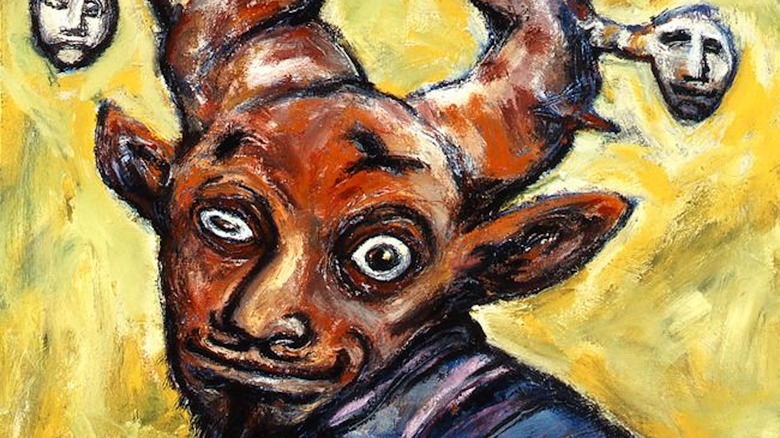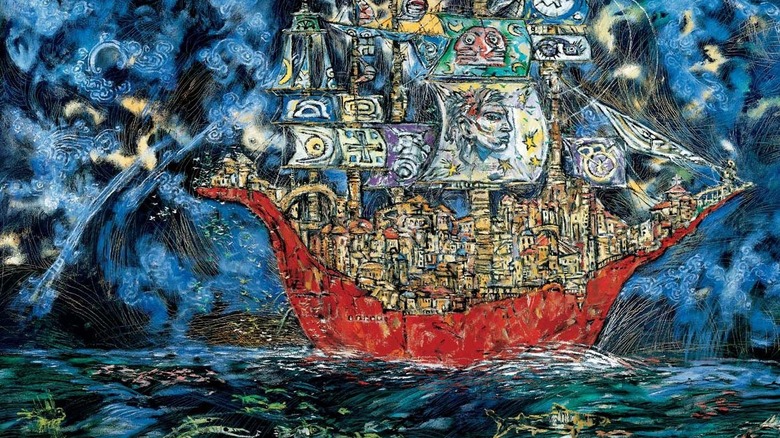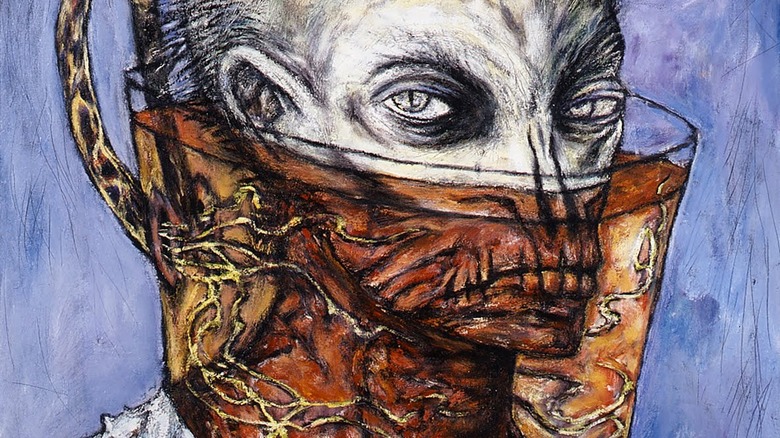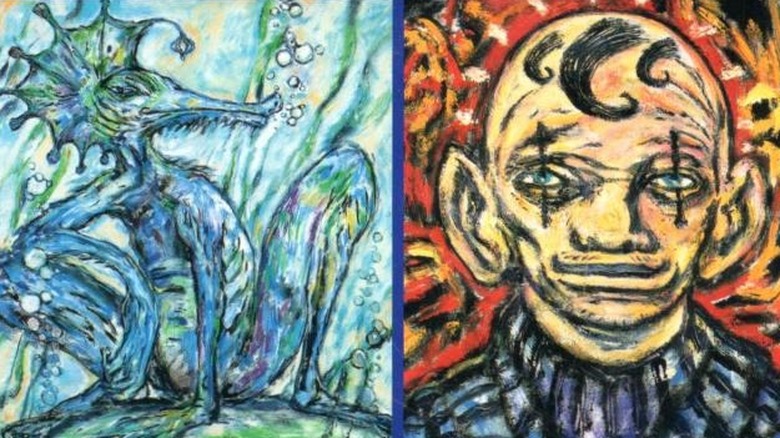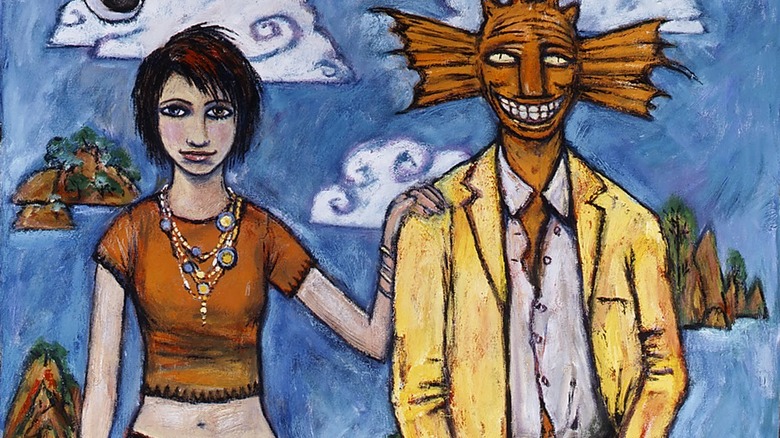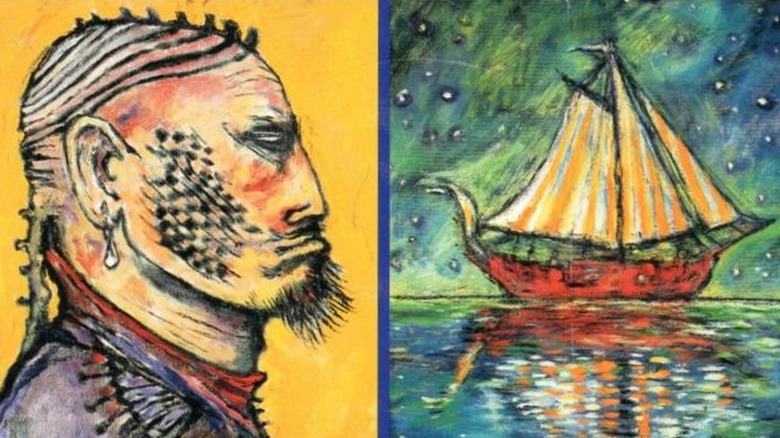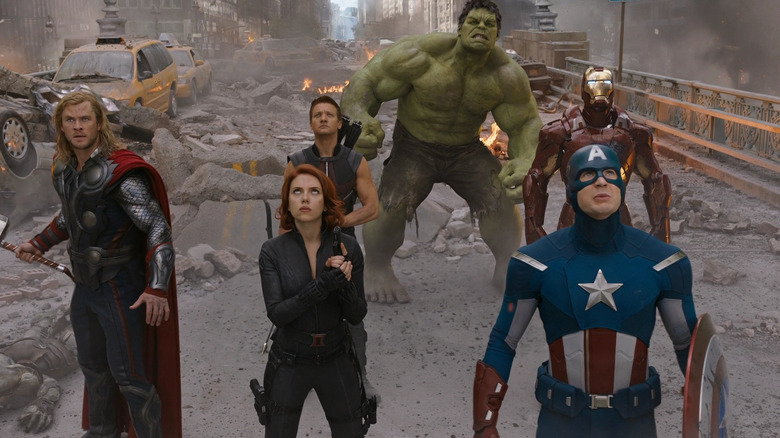Hellraiser Creator Clive Barker Could Have Been Disney's Next Big Thing
For every completed film or TV project associated with Clive Barker, there are probably 10 that never saw the light of day. Barker, for those unfamiliar, is the author behind the books "The Great and Secret Show," "Imajica," and "Weaveworld," each of them sprawling, interdimensional fantasy epics full of horror, queerness, sex, and violence. In 1986, Barker wrote the novella "The Hellbound Heart," which he adapted into the feature film "Hellraiser" the following year. Barker also wrote and directed the 1990 film "Night Breed" (based on his 1988 novella "Cabal") and the 1995 film "Lord of Illusions." He also wrote the short story that inspired "Candyman."
A look back over Barker's career, however (handily laid out on the author's website), reveals a spate of films and TV projects that were not made. There was a plan, once upon a time, to adapt his 1992 novel "The Thief of Always" to film. Those who have read the novel might mark its myriad similarities to Neil Gaiman's novel "Coraline" from a decade later, and the subsequent film that likely stole any thunder "The Thief" might have had. There was once a plan to adapt Barker's line of action figures, called "Tortured Souls." Barker once signed on to produce a movie inspired by the 1997 New Times article, "Myths Over Miami," written by Lynda Edwards.
Other failed projects include a feature film based on Barker's comic book "EctoKid," a film of his story "Down, Satan," and sequels to "Night Breed" and "The Midnight Meat Train." Many others remain planned.
One stalled Barker project towers above all the others, however. In 2000, Disney agreed to make an expensive, epic cross-media franchise based on Barker's planned five-books series of Y.A. novels called "Abarat."
The Abarat Quintet
The story of the "Abarat" quintet was fantastical and novel. A teenage girl named Candy Quackenbush lives in a boring, middle-of-nowhere town called Chickentown, Minnesota. While staring out at the featureless horizon one day, it mysteriously becomes an actual sea, and Candy — like Alice into Wonderland — is swept into an elaborate fantasy world. In the Sea of Izabella is an archipelago of 25 islands, with each one eternally trapped at a particular hour of the day. On Autland, it's always seven in the morning. On Yzil, it is always noon. On Ninnyhammer, it's always 10:00 p.m. The dark island of Gorgossium is the land of midnight. Candy finds herself pursued by the evil Christopher Carrion, who is drawn to her for mysterious reasons. It's also implied that the islands are losing their magical qualities due to the encroachment of advertising mascots. Barker originally conceived of a four-book series, but that was eventually expanded into a plan for five.
Back in 2000, Variety reported on the major deal that Barker had signed with Disney, which was hoping to form their own massive fantasy Y.A. novel universe to compete with the success of the Harry Potter novels and then-upcoming movies. The story goes that Barker had constructed the world of the "Abarat" by painting hundreds of large, color artworks (that appear in the novels). He then invited a Disney exec into his studio to describe the "Abarat" universe using only his paintings. Disney immediately committed to a massive "Abarat" multimedia project without having read a word of the books. Disney paid Barker $4 million for the property, intending to pay an additional $4 million as the project progressed.
The epic plan
Disney's plan wasn't small, and Disney representative Michael Mendenhall told Variety that "Abarat" was, essentially, going to be Disney's Next Big Thing. Mendenhall even seemed to imply that "Abarat" could expand from feature films into TV and even into Disneyland rides:
"[What drew Disney to the deal was] that the theatrical property could be developed with so many different creative executions: interactive games, TV animation, live-action TV, theme park rides, music, and reproduction of the art from the film. For us, this is a way to develop creative content that will be fresh for years to come. On this project, Clive clearly has a creative direction that's very in line with our studio."
Barker, as his fans know, is not necessarily known for creating audience-friendly fare. The lion's share of Barker's writing output is devoted to horror, and extraordinarily bloody horror at that; this is the man behind "Hellraiser" and "Candyman," after all. Despite Barker's reputation, Disney did not balk. Mendenhall was all-in on the project.
Given the broad, fantastical nature of "Abarat," a feature film was going to require state-of-the-art special effects. One character sported antlers with the heads of his seven brothers living in them. The villain's face was half-submerged in liquid. There were to be a lot of scenes aboard ships and on beaches. Myriad fantasy creatures were to be seen everywhere. The second book would see a sailing vessel infiltrating a flooding Chickentown. This was no modest endeavor. This was going to be Disney's "Lord of the Rings."
Optimism
Barker, in a 2001 issue of Fangoria, even came out as optimistic, saying:
"What they've done is something they've never done before: they've bought a world from the inside out. They came out and saw a house full of paintings, and heard me talk about the world and the characters and the philosophies, and they said, 'We want to exploit this material in every medium we're in, from theater through parks, through toys, whatever.' And that was my dream for this material. It's a wonderful marriage."
This broad plan revealed Disney's true intent: compete with Harry Potter. 2001 saw a massive shift in the way fantasy blockbusters were to be made. The first Harry Potter movie was most certainly going to be followed up by multiple sequels, and Peter Jackson's "Lord of the Rings" movies were all being shot at one time. Prior to Harry and Tolkien, blockbusters rarely endeavored to plan out multiple sequels ahead of time; it was seen as taboo. Give that we now live in a post-Marvel Cinematic Universe world — which is planned dozens of films in advance — the idea of waiting for a sequel almost seems anathema to the modern marketplace.
Disney saw the writing on the wall. They knew that vast, interconnected fantasy universes were the next big moneymaker. "Abarat" was their attempt to buy in.
Delays
While Barker set to work writing the "Abarat" books, Disney got to work on a film production. The first "Abarat" book was published in September of 2002, which, it seems, was meant to coincide more closely with a film release. Judging by what Mendenhall told to Publisher's Weekly in 2001, the film was bigger than initially anticipated, and the special effects were going to require a lot more work. He also suddenly seemed mysteriously concerned with the company brand. Mendenhall said, even prior to the publication of "Abarat," that the film was delayed:
"The reason [for the delay] is that we may want to push our film-making technology. If it were to be a combination of live-action and CGI, it's a minimum of three or four years to come out with a really fantastic property. Not all of the people he's painted will be a part of the movie, or a part of any other ancillary product that's created off of this. We will not do anything to damage the Disney brand, ever. We were so thrilled to get this project, Spielberg and Katzenberg and Fox and everybody were trying to get it. Everyone was pulling out all the stops. But we didn't razzle-dazzle. We basically went back and presented what our assets were, what our company would do and how we would do it."
These words are ominous. "How we would do it" implies that studio interference is nigh, and that higher-ups may be getting cold feet. As for Mendenhall's claim that Spielberg wanted to make an "Abarat" film, one might not be able to find any substantiation.
Years would pass, and no "Abarat" movie would be made
Everything falls apart
Screenwriter John Harrison ("Dinosaur") wrote a screenplay for "Abarat," and talked about how the film project was coming along ... in 2005. In an interview with Fangoria magazine (archived on Horror Asylum), Harrison talked about attempt to retain the darkness of the source material, which, he opined, was now possible thanks to how well the "darker" chapters in the Harry Potter film series were doing in terms of box office. The most recent entry, as of the interview, was "Harry Potter and the Goblet of Fire." Harrison said:
"We're obviously trying to design the movie for a broad audience, but I'm hoping that the darker aspects won't get completely removed. I have great faith in the whole grim-fairy-tale attitude about what these stories can be, and I believe that children can handle darker stories than we give them credit for. I hope that the success of the Lord Of The Rings trilogy, which didn't pull any punches in terms of its horrific elements, and the last Harry Potter movie will encourage the studio not to sanitize Clive's material."
Sanitize. Sanitize. Barker and Disney were clearly not a good match.
By 2006, it was clear that Disney simply didn't know what to do with "Abarat." On September 11, it was reported that Barker and Disney were splitting apart and that "Abarat" was no longer going to be the Next Big Thing, or indeed Anything At All. Barker had already completed two books by that time ("Abarat: Days of Magic, Nights of War" was published in 2004) and seemed a little discouraged by the dissolution of the Disney project. Although Barker had five books planned, as of 2011, he has only completed the first three.
Go f*** yourself
One of the main reasons seems to have been a change in management at Disney. One can comb through showbiz history and find any number of abandoned projects that new management regimes intentionally shelved, merely because they ere left over from the previous administration. Barker — in a 2007 interview with Bloody Disgusting, archived on the author's website, recalled the firing, the confusion from the company, and a very bad deal. He said:
"I pulled it away from Disney because to be very honest I did that deal because I was working with two men who I liked immensely and they swore to me they were not going anywhere and of course two months later they were gone. I watched as the Disney organization plodded its way through bouncing this thing back and forth not knowing what to do with it. Meanwhile I turned in a second book, which only confused them even more."
Barker clearly wanted out, a feeling that was validated when Disney offered to keep the "Abarat" project alive for several more years ... without paying him a dime. Barker said:
"There just came a point where last September their time was up with the option and it was time for them to come up with a number on the table to keep the material for a decent amount of time. Their lawyer came to us and said 'We're Disney, Clive's very lucky to be with us and here is what we propose: Rather than paying you X amount and keeping the material for another two years, we keep it for four years and pay you nothing'. And I said 'Go f*** yourself.'"
The MCU
Although Disney let "Abarat" go, their keen eye was still geared on a larger, interconnected fantasy universe. After "Abarat" fell apart, Disney — who had been seeking to buy Marvel comics for years — finally closed a deal on the massive superhero property in 2009. They immediately began making a series of interconnected superhero movies which are, rumor has it, quite successful. The Marvel Cinematic Universe altered everything about the way blockbusters are made, marketed, and talked about. To this day, Marvel movies are big business.
One can only imagine what the world would have looked like if Disney had stuck with their guns over "Abarat." Would we be living in a Clivr Barker renaissance? No superheroes would be seen, and the world would be obsessed with the 25 isles of the Abarat Archipelago. Kids would be riding "Abarat" rides, eating "Abarat" snacks, watching Disney+ "Abarat" TV shows, and meeting "Abarat" characters in plush suits at Disneyland.
However much a fan might enjoy the MCU, one cannot deny interest in a parallel universe where "Abarat" took off in its place.
